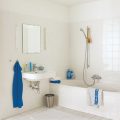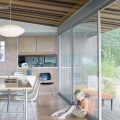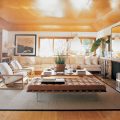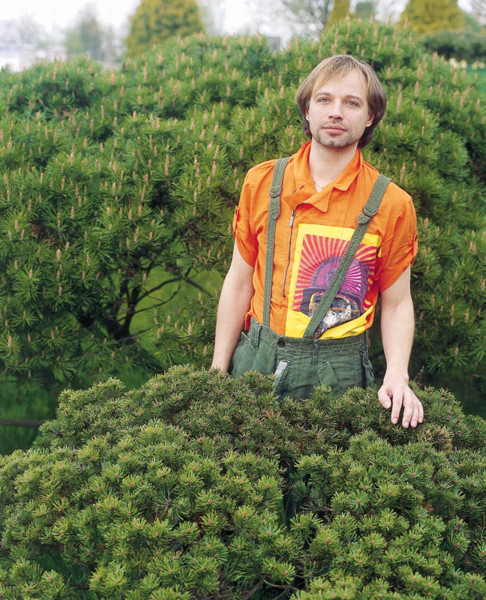 House in France
House in France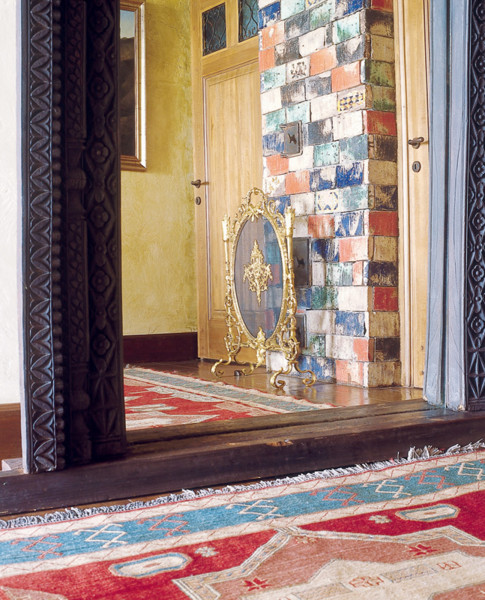 Hall on the second floor. The oven wall is faced with handmade tiles, Eco Ceramica. A carpet from the gallery of Mark Patlis ..
Hall on the second floor. The oven wall is faced with handmade tiles, Eco Ceramica. A carpet from the gallery of Mark Patlis ..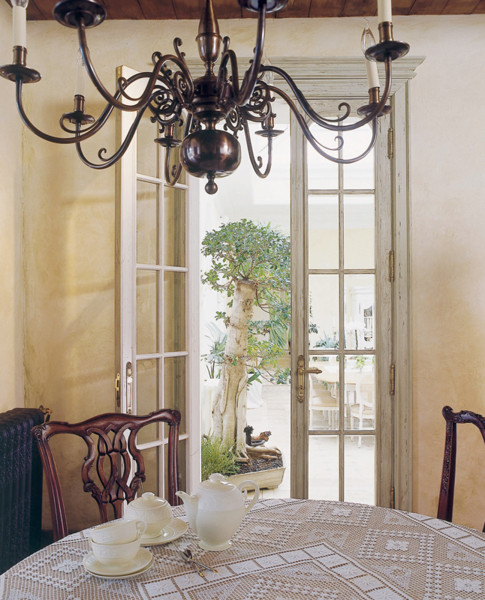 View from the dining room to the winter garden. The table is surrounded by six unsuited chairs. "They add vitality to the interior."
View from the dining room to the winter garden. The table is surrounded by six unsuited chairs. "They add vitality to the interior."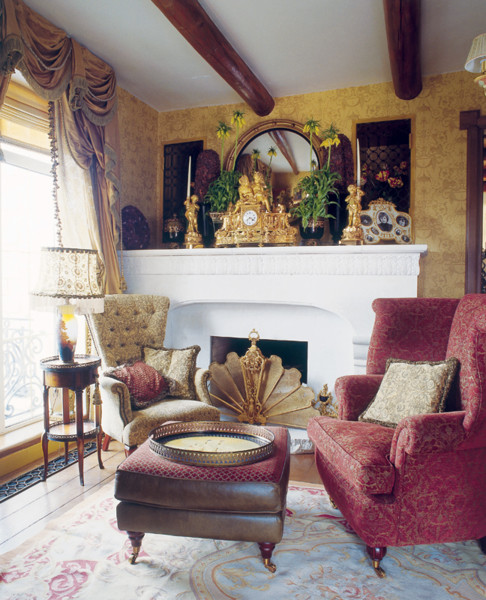 Library. The fireplace portal is made from the Moscow dolomite under the sketches of Alexander Grivko. Sewing curtains - salon "Window to Paris".
Library. The fireplace portal is made from the Moscow dolomite under the sketches of Alexander Grivko. Sewing curtains - salon "Window to Paris".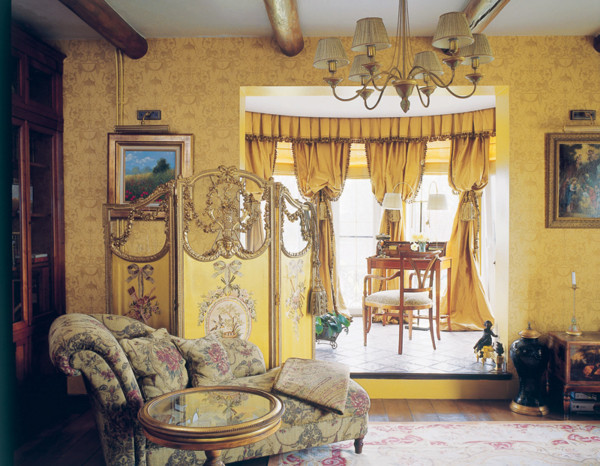 Living room. An old screen of the work of St. Petersburg masters. Round table, Savio Fir-mino. Chandelier, Baga. In the bay window there is a table and an armchair, Annibale Colombo. Curtains, salon "Window to Paris." At Christmas, the bay window becomes the main place in the house. It is here that, according to tradition, a huge spruce spruce is established.
Living room. An old screen of the work of St. Petersburg masters. Round table, Savio Fir-mino. Chandelier, Baga. In the bay window there is a table and an armchair, Annibale Colombo. Curtains, salon "Window to Paris." At Christmas, the bay window becomes the main place in the house. It is here that, according to tradition, a huge spruce spruce is established.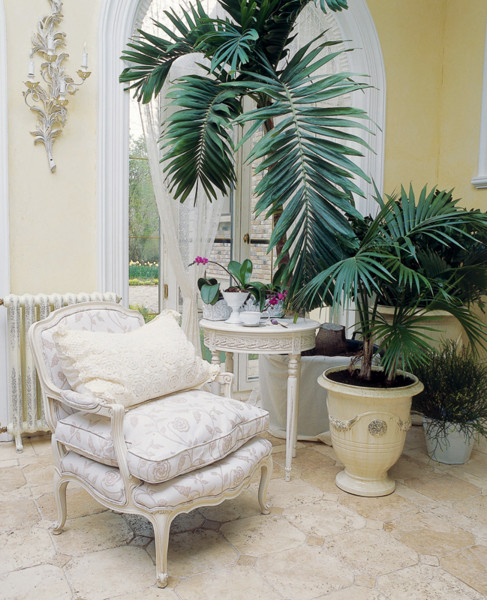
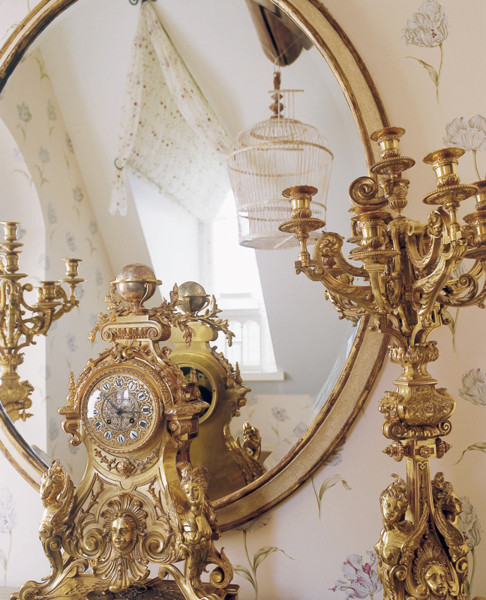 Fragment of "bedroom with tulips". Wallpapers, Sanderson.
Fragment of "bedroom with tulips". Wallpapers, Sanderson.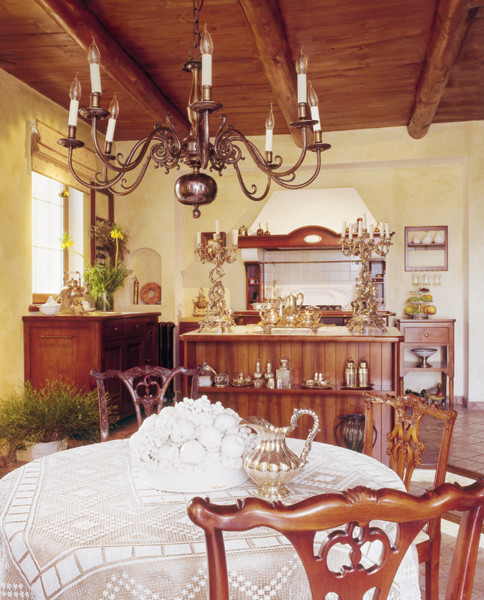 Kitchen Martini Mobili, salon "Tango". Under the lacy tablecloth on the table lies the inscription made at the request of the owner: Edere oportet, ut vivas, non vivere ut edas, which means: "There is to live, not live to eat." Candelabra of the XIX century, Christofle.
Kitchen Martini Mobili, salon "Tango". Under the lacy tablecloth on the table lies the inscription made at the request of the owner: Edere oportet, ut vivas, non vivere ut edas, which means: "There is to live, not live to eat." Candelabra of the XIX century, Christofle.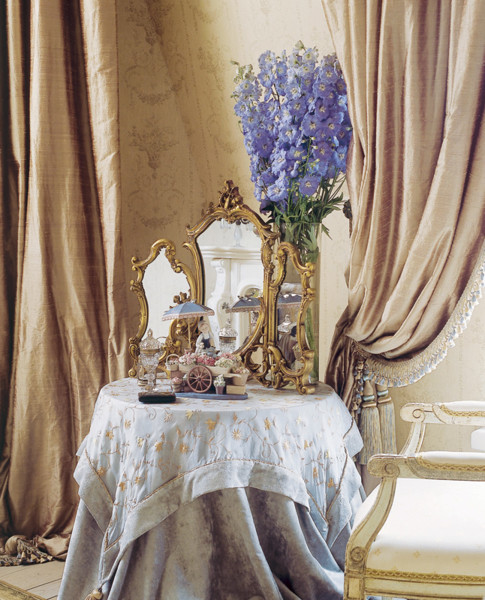 Master bedroom. The Marie-Antoinette bed from Simon Horn. Lust-ra was brought from France. Tables, Savio Firmino. Textiles, salon «Window to Paris».
Master bedroom. The Marie-Antoinette bed from Simon Horn. Lust-ra was brought from France. Tables, Savio Firmino. Textiles, salon «Window to Paris».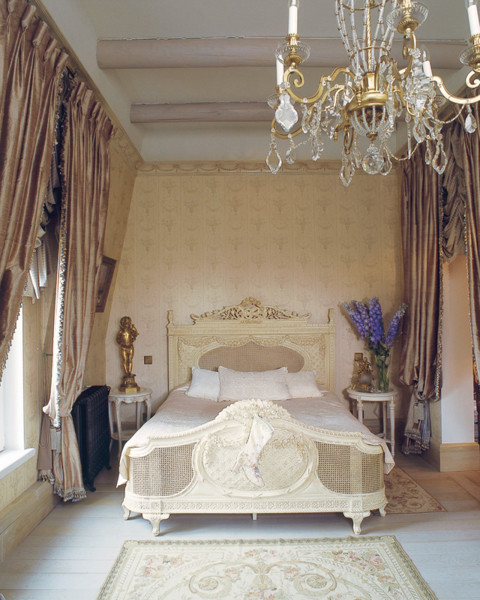 Master bedroom. The Marie-Antoinette bed from Simon Horn. Lust-ra was brought from France. Tables, Savio Firmino. Textiles, salon «Window to Paris».
Master bedroom. The Marie-Antoinette bed from Simon Horn. Lust-ra was brought from France. Tables, Savio Firmino. Textiles, salon «Window to Paris».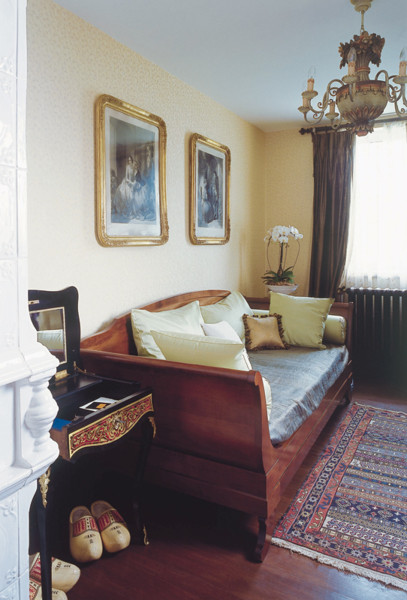 A guest room. Sofa, Morelato. The stove is faced with white tiles, folk handicrafts Vyalko.
A guest room. Sofa, Morelato. The stove is faced with white tiles, folk handicrafts Vyalko.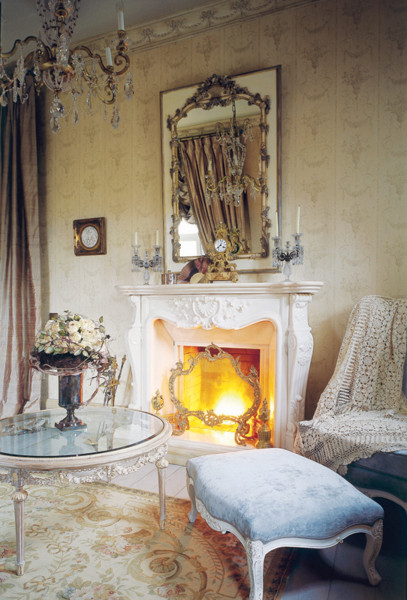 Fragment of the master bedroom. Mirror, Chelini. Fireplace supplies are brought from France. Table, Savio Firmino. On the fireplace - French clock beginning of the XVIII century. "Work perfectly!"
Fragment of the master bedroom. Mirror, Chelini. Fireplace supplies are brought from France. Table, Savio Firmino. On the fireplace - French clock beginning of the XVIII century. "Work perfectly!"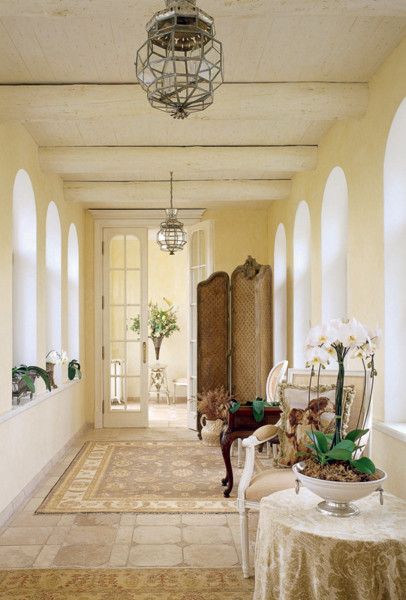 The house continues to grow. Last year, it was attached to the winter garden and a gym, connected by a gallery. Antique silver lanterns are brought from England. The floor is laid out with travertine.
The house continues to grow. Last year, it was attached to the winter garden and a gym, connected by a gallery. Antique silver lanterns are brought from England. The floor is laid out with travertine.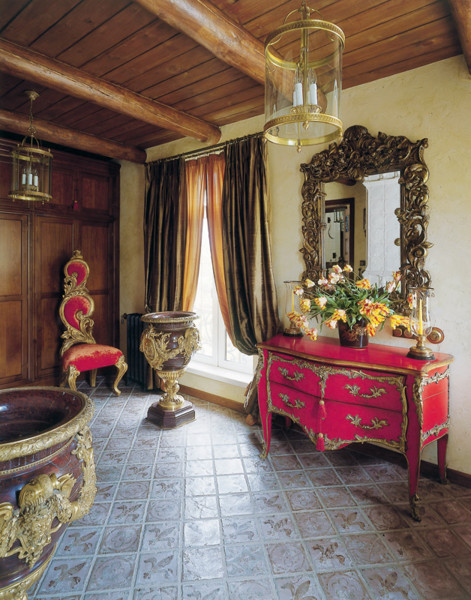 Hallway. French floor vases from the 19th century are among the many gifts from grateful clients. Chest of drawers, Moissonnier. Chair, Harrison & Gil. Tile, Eco Ceramica.
Hallway. French floor vases from the 19th century are among the many gifts from grateful clients. Chest of drawers, Moissonnier. Chair, Harrison & Gil. Tile, Eco Ceramica.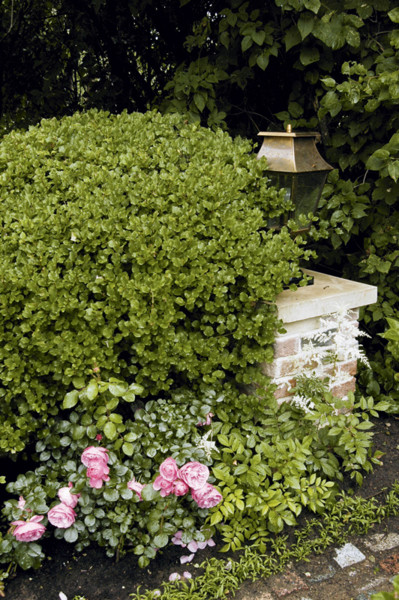 In the garden grows about forty varieties of English roses.
In the garden grows about forty varieties of English roses.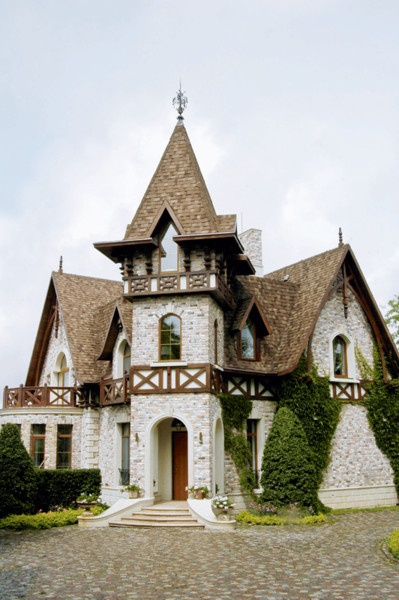 The house was built in the tradition of Norman castles.
The house was built in the tradition of Norman castles.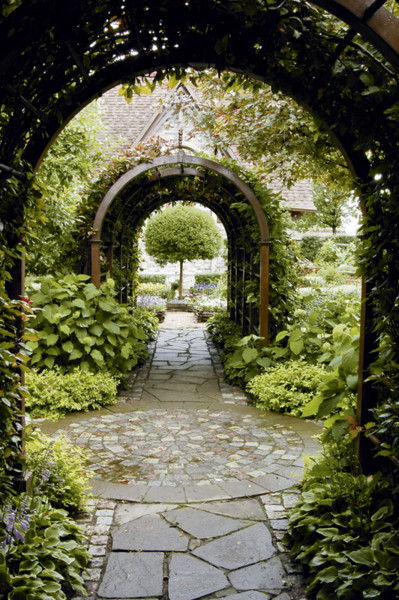 The arches are covered with apple trees of the sort "Lisette". The paths are lined with granite paving stones and sandstone.
The arches are covered with apple trees of the sort "Lisette". The paths are lined with granite paving stones and sandstone.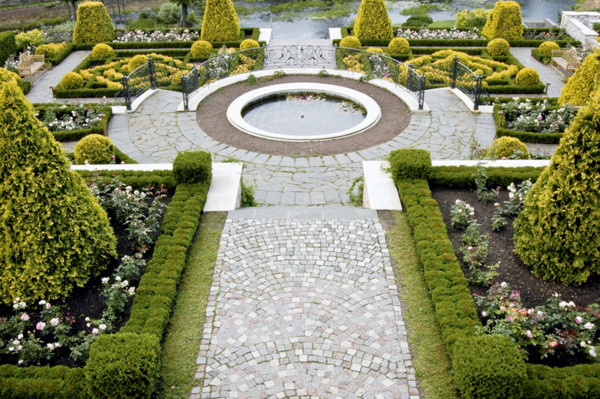 The main axis of stakeout was the living room window. In the center of the composition is a fountain (during the shooting it, unfortunately, was turned off). Forging - studio Katrina Ershova. Teak benches, Unopiu.
The main axis of stakeout was the living room window. In the center of the composition is a fountain (during the shooting it, unfortunately, was turned off). Forging - studio Katrina Ershova. Teak benches, Unopiu.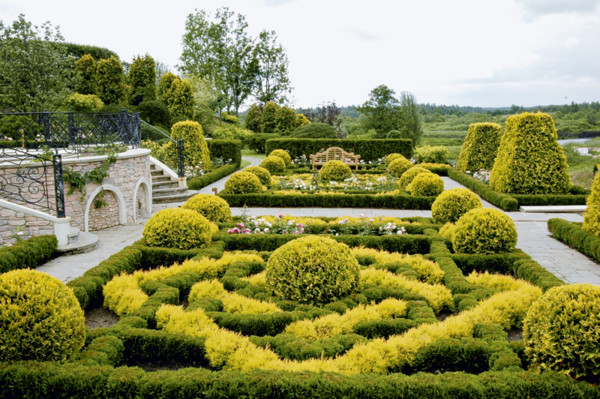 The main decorations of the stalls were tuya western in the form of balls and truncated pyramids.
The main decorations of the stalls were tuya western in the form of balls and truncated pyramids.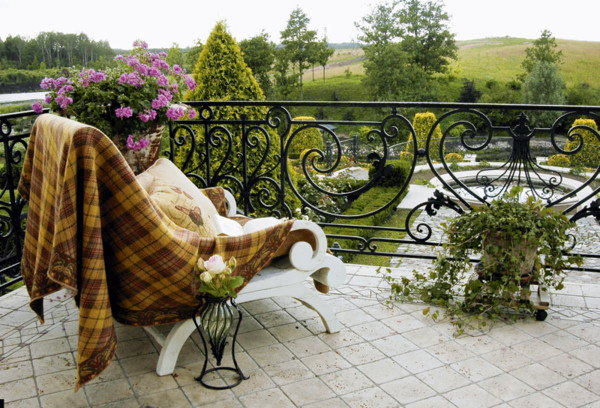 Admiring the garden is best, sitting on the adjacentto the dining terrace open. The view does not lose its charm all year round. Selective varieties of thuja western are perfectly tolerated by the cold. Is that the yellow varieties in winter acquire a light shade of bronze. Forged fences - studio Katrina Ershova.
Admiring the garden is best, sitting on the adjacentto the dining terrace open. The view does not lose its charm all year round. Selective varieties of thuja western are perfectly tolerated by the cold. Is that the yellow varieties in winter acquire a light shade of bronze. Forged fences - studio Katrina Ershova.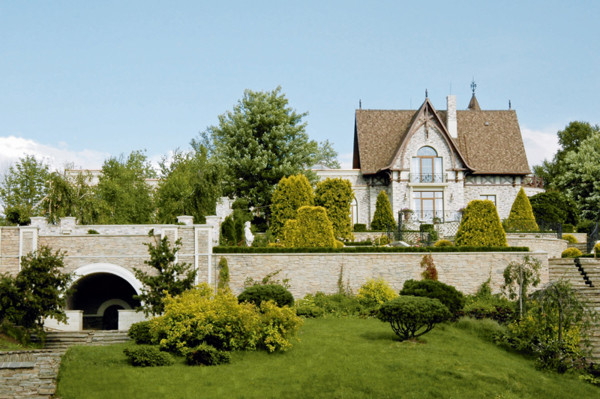 Terracing of the plot is made not only for the sake of beauty, but also for strengthening the soil, which is washed up by the river running along the site. Near the house are planted maples are silvery and maples are holly.
Terracing of the plot is made not only for the sake of beauty, but also for strengthening the soil, which is washed up by the river running along the site. Near the house are planted maples are silvery and maples are holly.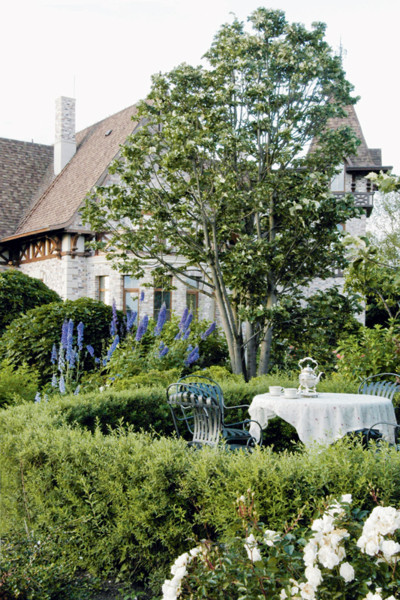 The "green living room" is fenced with a hedge of gray spiraea. The house is covered with a felt basswood.
The "green living room" is fenced with a hedge of gray spiraea. The house is covered with a felt basswood.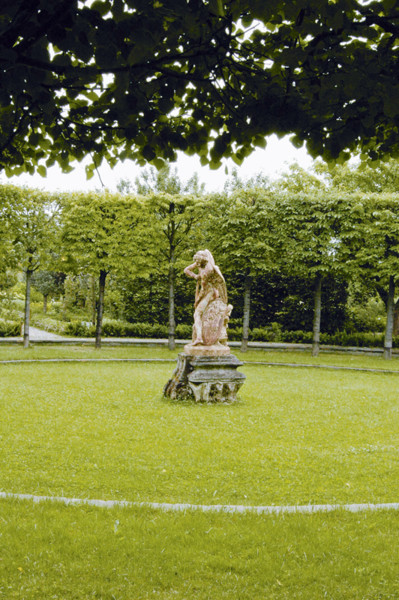 Cupid is hiding among the linden trellises(a 19th-century cast-iron sculpture brought from France). "Rusty and colorful, it suits the house very well in terms of color. In addition, cast iron, unlike bronze, is very easy to care for."
Cupid is hiding among the linden trellises(a 19th-century cast-iron sculpture brought from France). "Rusty and colorful, it suits the house very well in terms of color. In addition, cast iron, unlike bronze, is very easy to care for."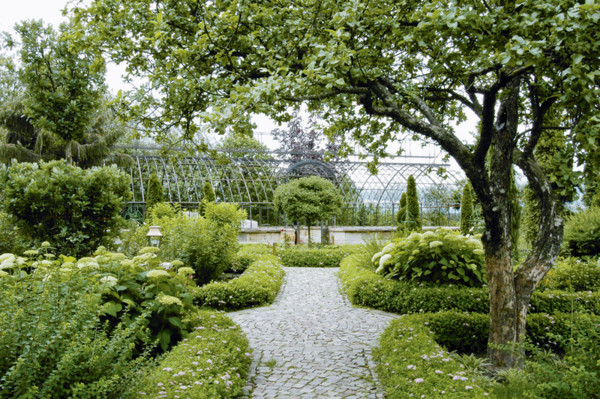 The mid-19th century greenhouse was brought from France. In the old part of the garden, several apple trees have been preserved since Soviet times.
The mid-19th century greenhouse was brought from France. In the old part of the garden, several apple trees have been preserved since Soviet times.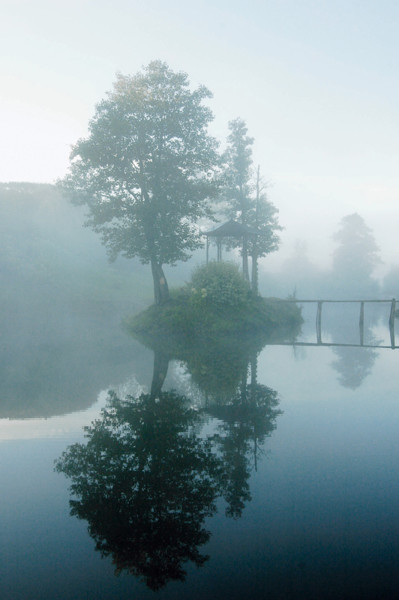 "First of all, we cleared the river running along the site and took care of those trees that were already growing there. In particular, about this old alder on an island with a gazebo. "
"First of all, we cleared the river running along the site and took care of those trees that were already growing there. In particular, about this old alder on an island with a gazebo. "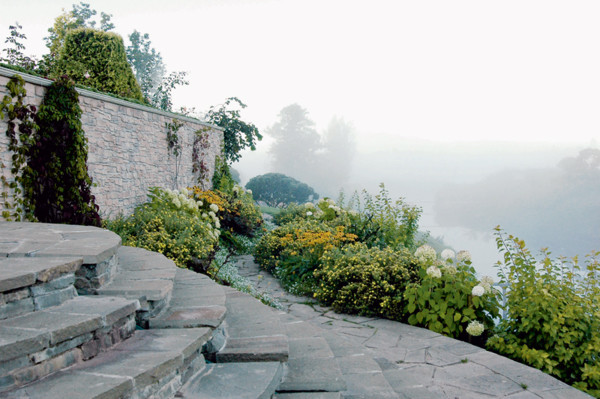 The staircase leading to the river is lined with cut sandstone. Along the paths blossom hydrangeas tree-like varieties "Anabel" and Kuril tea.
The staircase leading to the river is lined with cut sandstone. Along the paths blossom hydrangeas tree-like varieties "Anabel" and Kuril tea.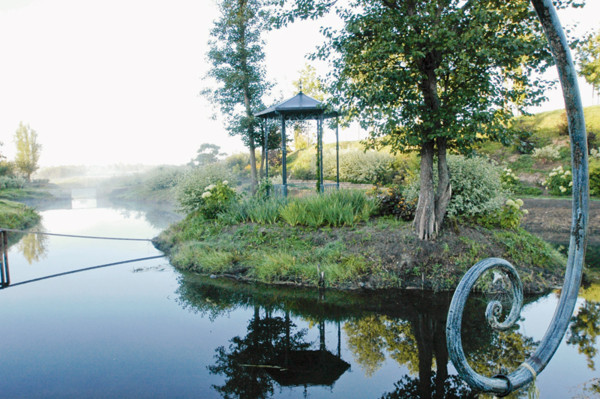 A gazebo on a small island in the middle of the river -one of the most romantic places in the garden. For the past few years, the art director of the landscape company Il Nature, Alexander Grivko, has been living in France for long periods of time (where he is engaged in the restoration of the ancient parks of the Cote d'Azur) and, by his own admission, has become "completely French". Following in the footsteps of the owner, his ancestral home, built in the image and likeness of a Norman castle, has also become French.
A gazebo on a small island in the middle of the river -one of the most romantic places in the garden. For the past few years, the art director of the landscape company Il Nature, Alexander Grivko, has been living in France for long periods of time (where he is engaged in the restoration of the ancient parks of the Cote d'Azur) and, by his own admission, has become "completely French". Following in the footsteps of the owner, his ancestral home, built in the image and likeness of a Norman castle, has also become French.
About the house
10 years ago, when my brother and I took upconstruction of this house, minimalism reigned in Russia. But it always seemed to me that this style does not suit the local climate. Our weather is mostly gloomy, sad. And if everything in the house is gray, the mood drops completely. I am closer to French interiors - when everything is in lace, frills, butterflies, flowers - when the density of things is so high that you can safely drag into the house everything you like, without thinking about whether this or that item will spoil the carefully thought-out concept of the living room. With this approach, after decades the house is filled with things that do not fit into any stylistic framework. Friends bring their own, fashion - its own, children - theirs, you - yours. This is life. When it came to interiors, they did not turn to the services of a professional decorator. I didn't like any of the Russians, and inviting someone from abroad at that time didn't really occur to me. So I had to do everything myself. I brought some things from Paris, ordered others from Moscow salons. My main goal was not to buy too many trendy items. When I went to salons, I specifically asked to see catalogs of unknown brands. Much was done the way my mother wanted. At her insistence, for example, all the wallpaper in the house is paper, and all the fabrics are natural. The "bedroom with tulips" (these flowers are everywhere: on the wallpaper, curtains, bedspreads and pillows) is also her idea. The house was conceived as a real family nest: warm, cozy, bright, with a large living room and a round table at which our whole family can gather. (So that nothing would distract from live communication, the living room was left without a TV. Why would it be needed there?)
About the garden
In parallel with the construction of the house, work beganwork on laying out the garden. «First of all, we cleared the river. Then we planted rows of mature tall trees to shield the area from the wind. A long time ago, the forest came almost right up to the village, but after Brezhnev's program to drain the swamps, the trees died, and now the settlement is surrounded for several kilometers by abandoned collective farm fields, across which a strong wind rushes. We had to build protection. The terracing of the area was done not only for the sake of beauty, but also to strengthen the soil. «Armed with stakes and signal tapes, we marked the boundaries of the future retaining walls right on the spot. The main thing in this matter was not to make a mistake with the height — so that the walls would not block the view from the living room to the river flowing at the foot of the hill». Along the axis of the «living room — the river» In front of the house there is a parterre with yellow and green thujas. Yellow thujas add optimism to the grey Russian landscape. They can lift your spirits in any weather. In England, similar geometric patterns are planted from boxwood and evergreen herbs. In our climate, the best option is dwarf varieties of western thuja (they were bred at the end of the 20th century). Unlike boxwood, it does not have to be covered for the winter. But for the first two years after planting, the snow around the trees should be sprinkled with ash or covered with spruce branches to protect the plant from the burns of the spring sun. I'm tired of all flowers, except... The plot of a professional gardener has turned into a springboard for scientific experiments. I wanted to see how English roses, which are not usually cultivated in Russia, would live in our climate. There are about forty varieties here, and they all feel great. At the foot of the house there are carpets of Stephanandra fruticosa. It turned out that, unlike the same dogwood, this plant does not freeze at all. And if it does freeze, it instantly recovers. Liquidambar, which is considered a risky plant in Russia and is therefore grown only in the Botanical Garden, also showed itself worthy. I planted about thirty varieties of apple trees here. Oddly enough, the varieties with pink and red flowers turned out to be more frost-resistant (although white-flowered ones are more common in Russia). There is also Brewer's spruce here. In the Moscow region, this tree does not take root due to poor ecology (the soft needles are sensitive to pollution), but here it feels great. What else? Some varieties of junipers... You can't remember everything. The garden does not lose its charm even at night. All light sources are directed downwards. The lighting does not blind the eyes, but at the same time the paths are clearly visible in the dark. We used spotlights to illuminate only the powerful crowns of the shaped trees. The felt linden looks very impressive. The back of its leaves is covered with silver fluff. It reflects the light, due to which the tree shimmers at night with a "moon-like" glow. Il Nature Company, tel. (495) 797 4740.






